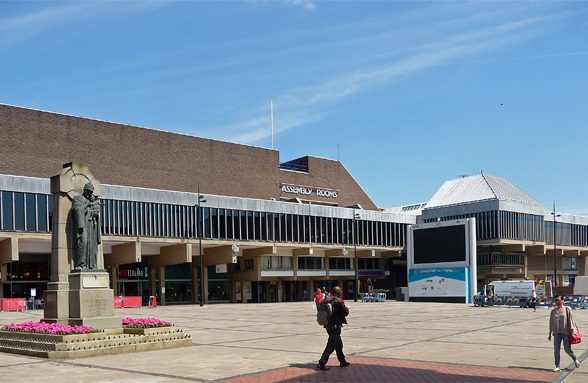This website uses cookies
This website uses cookies to enable it to function properly and to analyse how the website is used. Please click 'Close' to accept and continue using the website.



We’re concerned to learn that Derby City Council have recently voted to redevelop the Derby Assembly Rooms in favour of a new music and performance venue. The Society had supported a group of local architects who had been lobbying for its retention and imaginative re-purposing, and we wrote strongly in favour of upgrading the building to meet modern requirements. The Assembly Rooms are in good condition and there is no practical reason why they cannot be renovated and put to new use. The plans will mean the current venue – a fine surviving example of the work of Hugh Casson – will be completely demolished. Unfortunately the building has a Certificate of Immunity from listing and so little can be done to save it from the bulldozer.
The Assembly Rooms were built in 1971-6 to designs by Casson, Conder & Partners, in association with the Borough Architect’s Department. Sir Hugh Casson was a founding partner of the practice, and a major figure in post-war British architecture. He is perhaps best known for his role as the Director of Architecture for the Festival of Britain. Casson, Conder & Partners specialised in the design of adaptable auditorium spaces and venues. The practice is widely celebrated for their university buildings, many of which are now listed.
The Derby Assembly Rooms are on a larger scale than these earlier academic projects, but they share a similar ethos and aesthetic language. They are constructed on an exposed concrete frame, with large bay windows on the ground floor and an enclosed, cantilevered walkway above ground-level. These walkways form a striking feature as they are clearly expressed through the external structure. The staggered levels and bold sculptural form draw people in from the market place. The Assembly Rooms contain two concert halls, and were intended as the centre of an unrealised grand civic scheme in Derby city centre. This civic character is legible through its form and the integration of a range spaces for a variety of functions.
Public appreciation of post-war architecture is continually growing, and the opportunity for modern buildings to have a positive impact on urban centres is demonstrated by projects such the recent renovation of Patrick Gwynne’s 1967 extension to York Theatre Royal by De Matos Ryan, and the continuing success of London’s South Bank have highlights the popularity and importance of post-war performance venues and public space in the UK. With this in mind, we are deeply disappointed that this fine and rare regional example of a Brutalist entertainment building has been condemned.

Become a C20 member today and help save our modern design heritage.